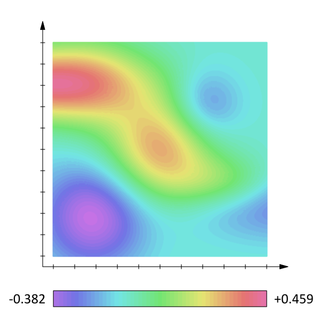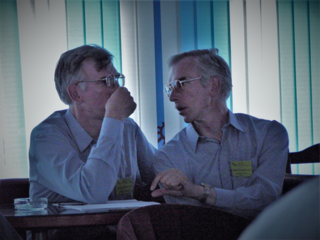Related Research Articles
In general relativity, a naked singularity is a hypothetical gravitational singularity without an event horizon.

In particle physics, quantum electrodynamics (QED) is the relativistic quantum field theory of electrodynamics. In essence, it describes how light and matter interact and is the first theory where full agreement between quantum mechanics and special relativity is achieved. QED mathematically describes all phenomena involving electrically charged particles interacting by means of exchange of photons and represents the quantum counterpart of classical electromagnetism giving a complete account of matter and light interaction.

Quantum gravity (QG) is a field of theoretical physics that seeks to describe gravity according to the principles of quantum mechanics. It deals with environments in which neither gravitational nor quantum effects can be ignored, such as in the vicinity of black holes or similar compact astrophysical objects, such as neutron stars, as well as in the early stages of the universe moments after the Big Bang.

In mathematics and physics, a scalar field is a function associating a single number to every point in a space – possibly physical space. The scalar may either be a pure mathematical number (dimensionless) or a scalar physical quantity.

Steven Weinberg was an American theoretical physicist and Nobel laureate in physics for his contributions with Abdus Salam and Sheldon Glashow to the unification of the weak force and electromagnetic interaction between elementary particles.

The Aharonov–Bohm effect, sometimes called the Ehrenberg–Siday–Aharonov–Bohm effect, is a quantum-mechanical phenomenon in which an electrically charged particle is affected by an electromagnetic potential, despite being confined to a region in which both the magnetic field and electric field are zero. The underlying mechanism is the coupling of the electromagnetic potential with the complex phase of a charged particle's wave function, and the Aharonov–Bohm effect is accordingly illustrated by interference experiments.

In the Standard Model of particle physics, the Higgs mechanism is essential to explain the generation mechanism of the property "mass" for gauge bosons. Without the Higgs mechanism, all bosons (one of the two classes of particles, the other being fermions) would be considered massless, but measurements show that the W+, W−, and Z0 bosons actually have relatively large masses of around 80 GeV/c2. The Higgs field resolves this conundrum. The simplest description of the mechanism adds a quantum field (the Higgs field) which permeates all of space to the Standard Model. Below some extremely high temperature, the field causes spontaneous symmetry breaking during interactions. The breaking of symmetry triggers the Higgs mechanism, causing the bosons it interacts with to have mass. In the Standard Model, the phrase "Higgs mechanism" refers specifically to the generation of masses for the W±, and Z weak gauge bosons through electroweak symmetry breaking. The Large Hadron Collider at CERN announced results consistent with the Higgs particle on 14 March 2013, making it extremely likely that the field, or one like it, exists, and explaining how the Higgs mechanism takes place in nature. The view of the Higgs mechanism as involving spontaneous symmetry breaking of a gauge symmetry is technically incorrect since by Elitzur's theorem gauge symmetries can never be spontaneously broken. Rather, the Fröhlich–Morchio–Strocchi mechanism reformulates the Higgs mechanism in an entirely gauge invariant way, generally leading to the same results.
In physics, the Brans–Dicke theory of gravitation is a competitor to Einstein's general theory of relativity. It is an example of a scalar–tensor theory, a gravitational theory in which the gravitational interaction is mediated by a scalar field as well as the tensor field of general relativity. The gravitational constant is not presumed to be constant but instead is replaced by a scalar field which can vary from place to place and with time.

In theoretical physics, quantum field theory in curved spacetime (QFTCS) is an extension of quantum field theory from Minkowski spacetime to a general curved spacetime. This theory uses a semi-classical approach; it treats spacetime as a fixed, classical background, while giving a quantum-mechanical description of the matter and energy propagating through that spacetime. A general prediction of this theory is that particles can be created by time-dependent gravitational fields (multigraviton pair production), or by time-independent gravitational fields that contain horizons. The most famous example of the latter is the phenomenon of Hawking radiation emitted by black holes.
The Abraham–Minkowski controversy is a physics debate concerning electromagnetic momentum within dielectric media. Two equations were first suggested by Hermann Minkowski (1908) and Max Abraham (1909) for this momentum. They predict different values, from which the name of the controversy derives. Experimental support has been claimed for both.
Stochastic electrodynamics (SED) is extends classical electrodynamics (CED) of theoretical physics by adding the hypothesis of a classical Lorentz invariant radiation field having statistical properties similar to that of the electromagnetic zero-point field (ZPF) of quantum electrodynamics (QED).

In particle physics, the history of quantum field theory starts with its creation by Paul Dirac, when he attempted to quantize the electromagnetic field in the late 1920s. Major advances in the theory were made in the 1940s and 1950s, leading to the introduction of renormalized quantum electrodynamics (QED). The field theory behind QED was so accurate and successful in predictions that efforts were made to apply the same basic concepts for the other forces of nature. Beginning in 1954, the parallel was found by way of gauge theory, leading by the late 1970s, to quantum field models of strong nuclear force and weak nuclear force, united in the modern Standard Model of particle physics.
In physics, superradiance is the radiation enhancement effects in several contexts including quantum mechanics, astrophysics and relativity.
Tevian Dray is an American mathematician who has worked in general relativity, mathematical physics, geometry, and both science and mathematics education. He was elected a Fellow of the American Physical Society in 2010.
Paul Kingsley Townsend FRS is a British physicist, currently a Professor of Theoretical Physics in Cambridge University's Department of Applied Mathematics and Theoretical Physics. He is notable for his work on string theory.
In theoretical physics, the logarithmic Schrödinger equation is one of the nonlinear modifications of Schrödinger's equation, first proposed by Gerald H. Rosen in its relativistic version in 1969. It is a classical wave equation with applications to extensions of quantum mechanics, quantum optics, nuclear physics, transport and diffusion phenomena, open quantum systems and information theory, effective quantum gravity and physical vacuum models and theory of superfluidity and Bose–Einstein condensation. It is an example of an integrable model.
Gary T. Horowitz is an American theoretical physicist who works on string theory and quantum gravity.

In theoretical physics, the dual photon is a hypothetical elementary particle that is a dual of the photon under electric–magnetic duality which is predicted by some theoretical models, including M-theory.

Vitaly Kocharovsky is a Russian-American physicist, academic and researcher. He is a Professor of Physics and Astronomy at Texas A&M University.

Vladimir Kocharovsky is a Russian physicist, academic and researcher. He is a Head of the Astrophysics and Space Plasma Physics Department at the Institute of Applied Physics of the Russian Academy of Sciences and a professor at N.I. Lobachevsky State University of Nizhny Novgorod.
References
- ↑ Corinne A. Manogue, "Vacuum Stability in Rotating Spacetimes", Physical Review D35 (1987) 3783-3795.
- ↑ Corinne A. Manogue, "The Klein Paradox and Superradiance", Annals of Physics181 (1988) 261-283.
- ↑ "Paradigms in Physics". Physics.oregonstate.edu. 10 April 2014. Retrieved 15 February 2015.
- 1 2 Reviews of The Geometry of the Octonions:
- Elduque, Alberto (2015), Mathematical Reviews, doi:10.1142/8456, ISBN 978-981-4401-81-4, MR 3361898
{{citation}}: CS1 maint: untitled periodical (link) - Brezov, Danail (2015), "Review" (PDF), J. Geom. Symmetry Phys., 39: 99–101
- Hunacek, Mark (June 2015), "Review", MAA Reviews
- Elduque, Alberto (2015), Mathematical Reviews, doi:10.1142/8456, ISBN 978-981-4401-81-4, MR 3361898